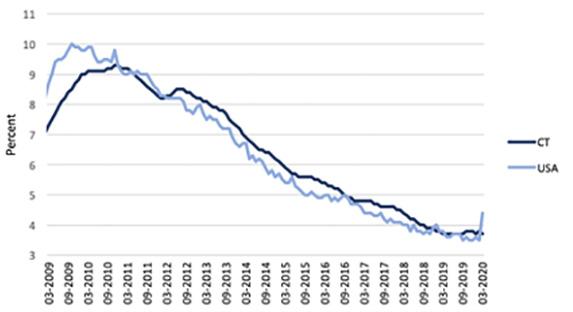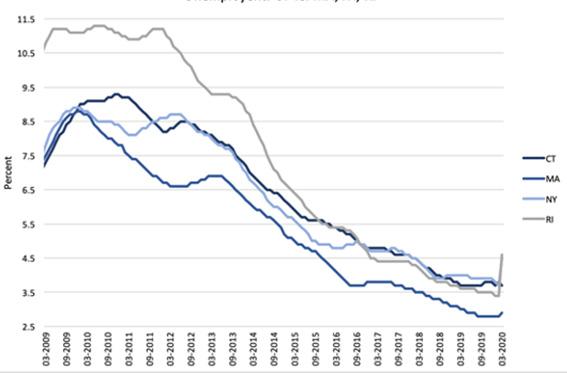
2 minute read
Unemployment
By Sara Bruckmann
As of March 2020, Connecticut’s unemployment rate has increased slightly to 3.7 percent. Although both are still below the natural rate of unemployment, the national rate has increased a bit more than Connecticut’s, currently at 4.4 percent. Two of Connecticut’s three surrounding states have seen an increase in unemployment in recent months as well. Unemployment rates in New York and Rhode Island have jumped to 4.5 percent and 4.6 percent, respectively. On the other hand, the Commonwealth of Massachusetts has remained steady at 2.9 percent.
An increase in unemployment is expected to be seen nationwide. With the outbreak of COVID-19, the job market has suffered greatly, and the regulations for those applying for unemployment insurance have been altered to advocate for the millions of Americans whose jobs are not considered essential and cannot work during this time. Over 22 million Americans have filed unemployment claims since March 13, when President Trump declared a national emergency in response to the COVID-19 pandemic, 350,000 of which are Connecticut residents. Typically, in two years, Connecticut would see fewer claims than have been filed in the past four weeks, according to the Connecticut Department of Labor.
Companies all over the state have been affected by the COVID-19 outbreak. Governor Lamont has asked Connecticut residents to “Stay Safe, Stay Home,” and all nonessential businesses have been closed until at least May 20. Yale New Haven Health has begun administering antibody tests to determine who is safe to return to work. These tests should be able to determine whether someone has been exposed to COVID-19, and therefore has an immunity to it. If successful, these tests may help Connecticut’s workers get back to their jobs sooner than originally expected.
The St. Louis Federal Reserve estimates that the national unemployment rate may reach 32 percent in quarter two of 2020, with 47 million Americans out of work. During the Great Depression, unemployment reached its peak at 24.99 percent in 1933.
Sara Bruckmann ’20
Major: Behavioral Economics Hometown: Trumbull, Connecticut
Figure 4: Unemployment: Conn. vs. U.S.

Figure 5: Unemployment: Conn. vs. Mass., N.Y., R.I.
Bizjournals.com, www.bizjournals.com/stlouis/news/2020/03/31/st-louisfed-economist-47-million-could-lose-their.html.
“Federal Reserve Economic Data: FRED: St. Louis Fed.” FRED, Federal Reserve Bank of St. Louis, fred.stlouisfed.org/.
Long, Heather. “U.S. Now Has 22 Million Unemployed, Wiping out a Decade of Job Gains.” The Washington Post, WP Company, 16 Apr. 2020,
www.washingtonpost.com/business/2020/04/16/unemployment-claims
coronavirus/.
Putterman, Alex. “Connecticut Hospitals Explore Antibody Testing for When Coronavirus Threat Fades, but Experts Warn of Limitations.” Courant.com, 21 Apr. 2020, www.courant.com/news/connecticut/hc-news-coronavirusantibody-tests-20200421-vu6r6so2uvfexama6td6cophaa-story.html.







